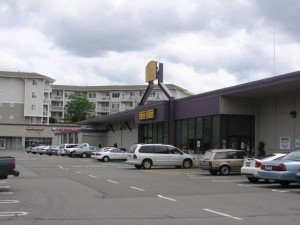By Heidi Madden & Chris Jacobsen

August 22, 1956 was the day the housewives of Crown Hill had been waiting for: The Plaza Shopping Center (a.k.a. Art’s Plaza) on 6th Ave. N.W. and Holman Road was having its grand opening. High on its tower, the iconic Art’s globe was spinning and there were gifts for everyone: fold-up plastic rain bonnets for the ladies, keychain screwdrivers for the men, and balloons for the kiddies.
The new 40,000-square-foot shopping center featured an Art’s Food Center, a Marketime Drugs, the Fiesta Buffet, Noonan’s Apparel, and a post office all under one roof. The massive shopping center was the brainchild of F.R. “Dick†McAbee, the prolific contractor whose scores of construction projects completed in the mid-1900s still have an impact on Crown Hill’s character, identity, and appearance.
The centerpiece of the development was the locally owned Art’s Food Center. Designed to appeal to the modern shopper, it featured a computerized meat scale, moving belts at the checkout stand, wide aisles, and 140 feet of frozen food cases housing the largest frozen food selection in the city.
The new Crown Hill location was the fourth grocery store for owner Art Case. Case may have been drawn to modern innovations, but he never lost sight of the value of his employees. He offered them respect and an attractive profit sharing plan, and most stayed with him for years.
The Art’s newspaper ad for the big grand opening featured pot roast for 29 cents a pound, four pounds of ground beef for 95 cents, a dozen ears of corn for 29 cents, a ten-pound sack of flour for 89 cents.
The new Holman Road Marketime Drugs was the third in the Seattle area. It offered the most varied inventory of any drugstore in the city. A shopper could get anything from a saltwater tackle box (grand opening price: $4.88) to a pound of tobacco ($1.09).

For builder Dick McAbee, the grand opening was the culmination of more than ten years of planning. It all started in the 1945 when McAbee purchased 105 acres of land between 12th Ave. NW and 3rd Ave. NW on Holman Road. It was rough pastureland where cattle from the Mikkelson Dairy grazed. With its rock-hard soil, ravines, and hills, it took vision to see its potential. Wartime shortages forced McAbee to put his plans for developing the land on hold for the time being.
In the early 1950s, McAbee was still waiting – waiting for the Crown Hill area to grow enough to sustain the shopping center he had planned on six acres of the land. In the meantime, he had other concerns: The intersection of 8th Ave. NW and Holman Road was, according to McAbee, a “death trap†because of the poor visibility drivers had when entering Holman from 8th NW. So he tenaciously pursued King County for the construction of an underpass. He also worked with the county to construct NW 100th Place to the north of the future shopping center. He built duplexes near the shopping center land.
By the mid-1950s, the time had finally come to begin the massive job of leveling the land in preparation for the shopping center.
McAbee collaborated with Art Case. Like Case, McAbee was fascinated with innovation and new ideas.
“He and Art became fast friends, and Art was a character,†said his son, Herb McAbee. “He would get ideas of stores he wanted to go see. And Dad was a tremendous guy for wanting to go look at things.â€
McAbee decided the roof of the shopping center would be built using lift slab construction, something never before attempted in the Pacific Northwest. Five massive slabs of 10-inch thick concrete, together weighing about 2,000,000 pounds, were poured onsite and slowly lifted in place with hydraulic jacks. This new method saved time and money and allowed greater versatility in planning interior walls. Leaving no stone unturned, McAbee had the roof decorated with colored roofing aggregate so that a giant collage would be seen from the air.
Art’s Plaza served Crown Hill for over 40 years and was arguably its most recognizable landmark. In 1970, it underwent a major remodel by F.R. McAbee, Inc. that added 10,000 square feet. It was decorated with the earth tones popular at the time. By then, Marketime had become Fred Meyer’s Marketime Drugs – where shoppers could buy anything from candy to auto supplies to a television set. Improvements to Art’s Food Center included an extensive gourmet section, a delicatessen, an expanded wine selection and a refrigerated floral department.
In 1976, Art’s Food Center took over the entire building. Art’s continued many of the popular Fred Meyer departments. The restaurant, a popular hangout for retirees, also remained, as did the post office and pharmacy. Video rentals were added later.

The most recent change was also the most sweeping: the 1998 acquisition of Art’s Food Center by Quality Food Centers. Crown Hill residents had mixed feelings and many were slow to embrace the change. QFC treaded lightly and continued the pharmacy, the video rentals, and the post office. The restaurant was continued for a time but was eventually replaced by a large and comfortably appointed Starbucks.
Art Case passed away before QFC acquired the store, and Dick McAbee passed away in 1999: two modern-day pioneers whose time had come and gone. Much has changed since that big grand opening over a half century ago. But the globe is still spinning, and we can still buy our groceries at 6th and Holman.


Special thanks to Herb and Sue McAbee.
Sources:
- Mitchell, Robert R. “We Lived in the Twentieth Century†The Life Story of Dick and Julia McAbee, Self Published, 1992
- http://www.seattlepi.com/neighbors/crownhill
- Seattle Times 5/6/99, 4/9/99, 7/19/98
- The Seattle Daily Times, 4/20/70, 4/5/70, 8/23/56, 8/21/56, 6/10/56, 12/4/55
- Ballard News Tribune 12/26/84

Chris and Heidi, thank you so much for the research and effort to get this history down.
Carol